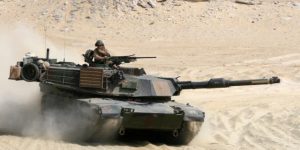
A U.S. Marine Corps M1-A1 Abrams main battle tank can positively identify friendly forces that have JCIMS with the use of infrared and thermal optical technologies. Additionally, the M1-A1 Abrams is also being protected from friendly fire with JCIMS installed on the platform. Photo by Cpl. Theodore W. Ritchie
The fog of war is an element of battle, which has plagued Armies throughout the entirety of military history. In Operation Desert Storm, approximately 24 percent of U.S. casualties were the result of direct fire fratricide. During the earliest phases of Operation Enduring Freedom and Operation Iraqi Freedom all eyes were keeping careful watch to see how ground forces world correct earlier friendly fire problems.
One solution, which has been fielded incrementally since 1995, is the Joint Combat Identification Marking System (JCIMS). JCIMS, is managed by Product Director Target Identification and Meteorological Sensors (PD TIMS), and consists of three components: Combat ID Panels (CIP), Thermal ID Panels (TIP) and Phoenix Infrared lights. This combination, which is fielded on U.S. ground force vehicles for both the Army and Marines Corps, provides friendly forces through the use of infrared and thermal optical technologies, a capability that helps to positively identify vehicles on the battlefield and reduce the risk of friendly fire upon their comrades.
“CIPs are passive emitters that are mounted on vehicles. When viewed through a thermal optic a distinctive signature is visible that helps make a more informed ‘shoot/don’t shoot’ decision at the point of engagement,” said Mike Starr, PD TIMS, Combat ID liaison to U.S. Army Armor Center.
CIPs are the primary ground-to-ground thermal marking device for the ground force, while the TIP is the primary air to ground marker as it offers fixed and rotary winged aircraft situational awareness of
the location of friendly forces on the ground. The Phoenix Infrared light gives off a continuous signal, which can be viewed by forces using image intensification technologies like night vision goggles. During mounted operations the Phoenix IR beacon is used primarily by drivers of combat and support vehicles to maintain situational awareness of where they are relative to the other platforms in their formation. The Phoenix IR beacon is also a resource for dismounted soldiers equipped with night vision goggles and is used to mark personnel, caches, obstacles, obstacle lanes, sectors of fire, etc.
When used with the appropriate Techniques, Tactics, and Procedures (TTPs), the CIP, TIP and Phoenix Infrared light significantly reduce the chance of mistakenly engaging friendly units.
“JCIMS is compliant with the standard NATO agreement 2129,” notes Starr. The standardization agreement ensures the system meets the wavelength and optic requirements for the NATO community. With various NATO ground and air forces, participating in the Afghanistan coalition force is it imperative that they be able to positively identify targets before engaging.
The JCIMS components themselves are relatively simple technologies that are fairly inexpensive. Following their introduction into the Army and Marine Corps arsenals in 1995, the system’s capabilities have significantly improved over time. However, the improvement is not necessarily related to changes made on the two types of panels and the Phoenix light. Increased performance has been advanced by the optical technologies used to view them such as the Long Range Advanced Scout Surveillance System (LRAS3), first and second generation forward looking infrared (FLIR) and Night Vision goggles all of which have improved and therefore enhanced the ability of Soldiers, Marines and NATO forces to identify friendly forces.
Since first coming online 15 years ago, more than 80,000 JCIMS have been fielded for use by the Army and Marine Corps. The systems are protecting everything from M1 Abrams tanks to HMWVV and Stryker vehicles.
Currently the Army is installing the three-component system on Maneuver Brigade Combat Team vehicles in both the active component and Army National Guard. Additionally, the Marine Corps has mandated that JCIMS be incorporated onto the vehicles for all deploying Marine Expeditionary Units (MUEs).
Fielding of JCIMS will continue through Fiscal Year 2011 with eight to 12 Brigade Combat Teams being equipped and trained a year. The Training & Doctrine Command (TRADOC) institutional training centers as well as the combat training centers at Fort Irwin, Cailf. and Fort Polk, La. have been equipped with JCIMS, so units can train with the actual system during maneuver exercises, prior to deployments.
The future for JCIMS includes new mounting methods that will ensure the panels stay affixed to the vehicle they are protecting, which is a response to lessons learned in both OEF and OIF. As new vehicles are introduced into the U.S. ground forces inventory, PD TIMS is planning to interface JCIMS with the Joint Light Tactical Vehicle and other modernization ground platforms.
JCIMS, which was once a quick-fix solution the result of a Combat ID General Officer Steering Committee directed by former Chief of Staff of the Army Gen. Gordon Sullivan in 1991, has become a mainstay in the Army and Marine Corps inventory. ” For more than a decade the JCIMS has proven to be a simple but effective life saving capability for U.S. ground forces and will continue to provide the friendly force target identification needed by our Warfighters to avoid incidents of fratricide,” said Michael Karpie, acting director PD TIMS.
An additional boost for combat identification is in the works as the Army and Marine Corps work out the requirements of Joint Cooperative Target Identification -Ground (JCTI-G) system, which would be a more robust, active cooperative target ID capability. It is anticipated that the JCTI-G program will enter the Material Solution Analysis phase this fiscal year.
The JCTI-G would provide Soldiers and Marines with a greater understanding of the battlefield and build upon the success JCIMS has brought in terms of preventing fratricide.